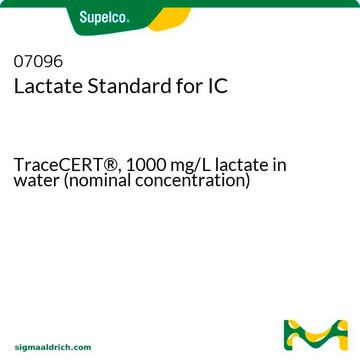PHR1215
Lactic acid
Pharmaceutical Secondary Standard; Certified Reference Material
Synonym(s):
DL-Lactic acid, 2-Hydroxypropionic acid
About This Item
Recommended Products
grade
certified reference material
pharmaceutical secondary standard
Quality Level
agency
traceable to USP 1356734
API family
lactic acid
form
liquid
CofA
current certificate can be downloaded
technique(s)
HPLC: suitable
gas chromatography (GC): suitable
refractive index
n20/D 1.425 (lit.)
bp
122 °C/15 mmHg (lit.)
density
1.209 g/mL at 25 °C (lit.)
application(s)
cleaning products
cosmetics
food and beverages
personal care
pharmaceutical (small molecule)
storage temp.
2-8°C
SMILES string
CC(O)C(O)=O
InChI
1S/C3H6O3/c1-2(4)3(5)6/h2,4H,1H3,(H,5,6)
InChI key
JVTAAEKCZFNVCJ-UHFFFAOYSA-N
Looking for similar products? Visit Product Comparison Guide
General description
Pharmaceutical secondary standards for application in quality control, provide pharma laboratories and manufacturers with a convenient and cost-effective alternative to the preparation of in-house working standards.
Application
- Quantitative analysis of four short-chain fatty acids and lactic acids by high-performance liquid chromatography (HPLC) combined with a UV detector from the supernatant of bacterial cultures
- Spectrophotometric determination of lactic acid at 390 nm in biological cultural and dairy products
Analysis Note
Footnote
Recommended products
Application
related product
signalword
Danger
hcodes
Hazard Classifications
Eye Dam. 1 - Skin Corr. 1C
supp_hazards
Storage Class
8A - Combustible corrosive hazardous materials
wgk_germany
WGK 1
flash_point_f
235.4 °F - closed cup
flash_point_c
113 °C - closed cup
Choose from one of the most recent versions:
Already Own This Product?
Find documentation for the products that you have recently purchased in the Document Library.
Customers Also Viewed
Articles
A new RP-HPLC method is proposed for the determination of organic acids in 100% aqueous mobile phase using an Ascentis® Express AQ-C18 column
Protocols
Separation of DL-Lactic acid, ~90% (T)
Science Slam panel: Leading gene therapy developers discuss commercialization challenges and the importance of robust process development plans.
Chromatograms
application for HPLCapplication for HPLCOur team of scientists has experience in all areas of research including Life Science, Material Science, Chemical Synthesis, Chromatography, Analytical and many others.
Contact Technical Service






